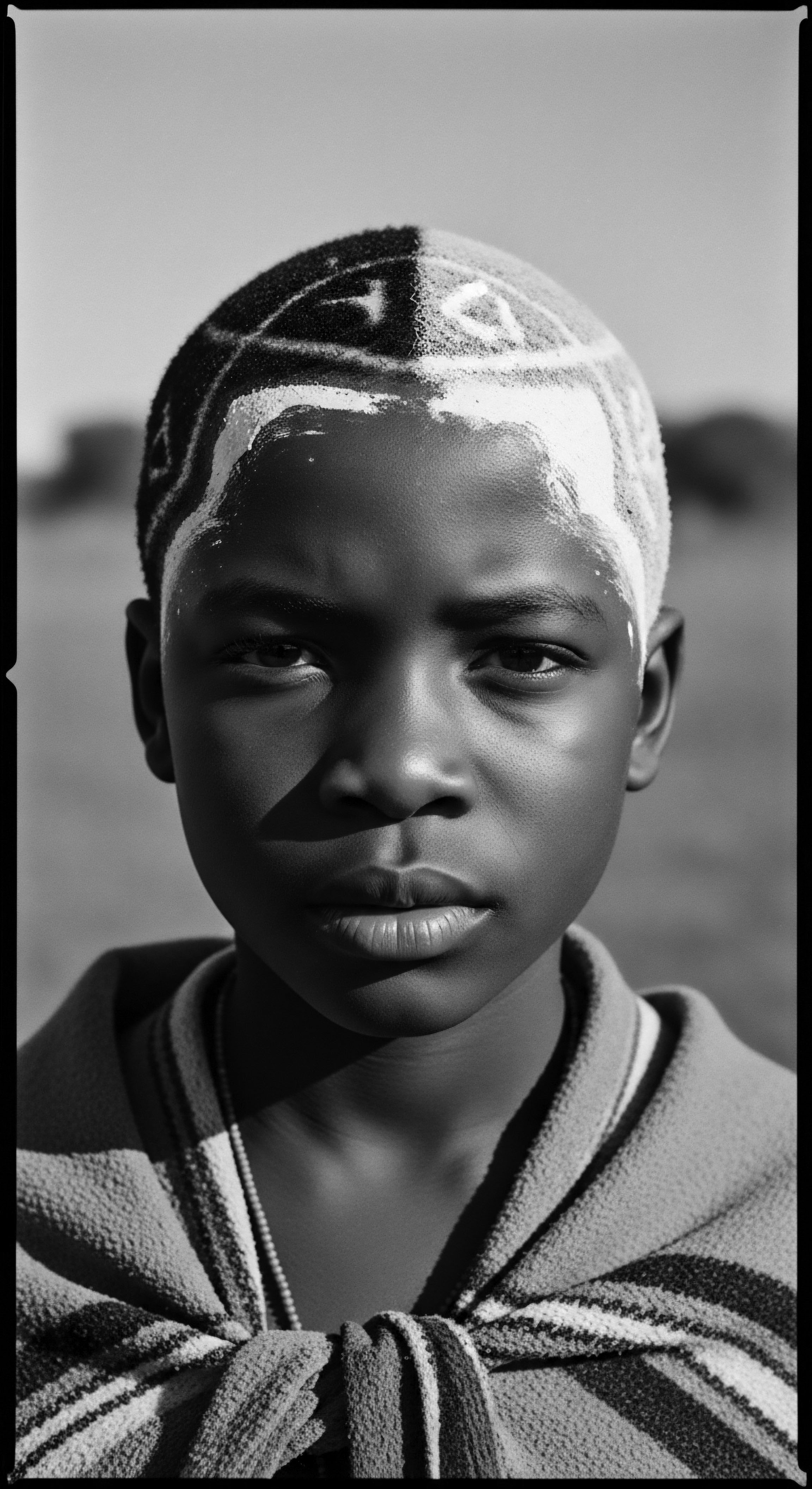
Roots
Feel the ancient earth beneath your feet, a gentle hum rising through the soles, speaking of deep time. It is a story whispered through generations, carried on the very wind that rustles the leaves of ancestral trees. This narrative is for you, a seeker of understanding, for whom textured hair holds more than mere strands; it holds histories, memories, and profound identity. To truly comprehend the spirit of textured hair care, we must first journey to its source, to the fundamental materials that first shaped the tools of adoration and maintenance ❉ the early comb.
These instruments were never simply functional items. They were extensions of the earth itself, crafted with ingenuity and reverence, holding within them the earliest understanding of textured hair’s unique needs and its inherent grace.
The genesis of hair combs stretches back across millennia, reaching into the very beginnings of human communal life. Archaeological finds across various continents reveal their use dating as far back as 8000 BCE in places like Syria, with Egyptian examples from around 5500 BCE. Early human societies, living in intimate relationship with their surroundings, sought practical solutions for grooming, untangling, and styling hair. These initial combs, often simple in their form, represented the raw ingenuity born from necessity and a primal appreciation for personal appearance.
For textured hair, with its natural coil and density, a specific comb architecture became essential ❉ widely spaced teeth, strong enough to navigate the unique spring of each curl without breakage. This form, predating our current naming conventions, was a silent testament to the hair’s inherent structure, an unspoken acknowledgment of its powerful nature.

What Materials Were First Shaped by Human Hands?
The primary materials available to early communities dictated the composition of these ancient grooming tools. These were gifts from the natural world, chosen for their inherent strength, workability, and availability. Across Africa, in ancient Kemet (Egypt) and Kush (Sudan), bone and wood feature prominently in archaeological records, dating back over 5,500 years. These finds often appear buried with their owners, suggesting a deeply held belief in hair’s sacredness and the tools used to tend it.
- Wood ❉ Across diverse African cultures and beyond, wood was a consistently favored choice for combs. Its accessibility in forested regions, coupled with its relative ease of carving, made it an ideal medium. Different wood types offered varying densities and grain patterns. In North Africa, olive and other hardwoods provided durability; West African communities might select rubber wood or mahogany for their fine texture; while South Africa saw red sandalwood and yellow sandalwood employed, displaying vibrant hues. The Ashanti people of Ghana, for example, crafted combs with geometric shapes and symbolic figures from locally sourced wood. This organic material, when smoothed and polished, moved through coils with less friction than some harder alternatives, preventing undue stress.
- Bone ❉ From the earliest Stone Age, bone provided a robust and adaptable material for tool creation. Animal bones, particularly long bones, offered structural integrity, capable of being shaped into strong, widely-spaced teeth ideal for textured hair. Evidence from Predynastic Kemet reveals early combs crafted from bone, often in a ‘pik’ form, a design remarkably similar to the modern afro pick. Such bone tools were recovered from sites like Dawu in Ghana, dating to the 17th-18th centuries CE, bearing a striking resemblance to combs used by enslaved African people in the Americas, speaking to a persistent design lineage. Beyond the African continent, Indigenous communities in the Americas also fashioned combs from bone, including the Pomo and Yuki peoples who used strong, fibrous roots and bundles of fibers as brushes and comb-like tools.
- Ivory and Shell ❉ In regions where they were available, ivory and various shells also served as materials for combs, particularly for those of higher status. Ancient Egypt saw ivory combs, often intricately carved and considered luxurious items, found in tombs of the wealthy, signaling status and luxury. These materials, while more challenging to work, allowed for exquisite detailing and a smooth finish, lending themselves to both practical use and ornamental display. Pacific Island communities crafted combs from coconut shell, sea shell, and turtle shell, often adorned with beadwork or carved motifs.
The earliest combs, born from the bounty of the earth, were functional tools and expressions of cultural identity.
The choice of material was rarely accidental. It reflected local ecosystems, spiritual beliefs, and the social fabric of the community. A comb made of a particular wood might be chosen not only for its practical qualities but also for the tree’s medicinal properties or its symbolic ties to fertility or protection.
Similarly, motifs carved into bone or wood often conveyed tribal identity, rank, fertility, or spiritual connections, making each comb a unique declaration of heritage. This deep connection between material, craft, and cultural meaning laid the groundwork for how textured hair, and the tools used in its care, would continue to hold profound significance across time and geography.

Ritual
The transition from raw material to revered tool marks a profound shift in human interaction with their environment. Early textured hair combs moved beyond simple utility; they became central to daily rituals, community bonds, and the very articulation of self. This transformation was not a sudden event, rather a gradual unfolding where the rhythms of life, the wisdom of the elders, and the deep understanding of textured hair converged.
The act of tending hair, particularly with these ancestral implements, transcended mere grooming. It became a tender exchange, a moment of connection, a silent language spoken between hands and strands.
In countless traditional societies, hair care was a communal activity, a time for sharing stories, imparting wisdom, and strengthening familial ties. The comb, shaped from natural elements, was at the heart of these gatherings. It was not uncommon for grandmothers to comb the hair of their grandchildren, meticulously detangling and styling, while simultaneously sharing oral histories, lessons of resilience, or ancestral narratives.
This practice instilled in younger generations a profound respect for their hair, recognizing it as a living heritage, a physical manifestation of their lineage. The very feel of a smoothly carved wooden comb against the scalp became synonymous with comfort, care, and the continuation of tradition.

How Did Design and Ornamentation Reflect Ancestral Values?
Beyond their practical application, ancestral combs were canvases for artistic expression and carriers of symbolic meaning. The designs etched or carved into wood, bone, or ivory were seldom arbitrary. They often depicted animals, geometric patterns, or human figures, each conveying specific cultural messages. For instance, archaeological findings from ancient Kemet show combs decorated with birds, bull’s horns, or hippopotamus, signifying reverence for the natural world and its powerful creatures.
These adornments served as visual affirmations of tribal identity, social standing, spiritual beliefs, and even a person’s life stage. A comb could communicate marital status, a rite of passage, or the lineage of its owner.
| Material & Origin Wood (Ashanti, Ghana) |
| Common Motifs & Symbolism Geometric shapes, stylized figures (e.g. figure with out-stretched arms). |
| Associated Cultural Significance Expressions of beauty, gifts during important life events like marriage, representations of family lineage. |
| Material & Origin Bone (Ancient Kemet/Egypt, Dawu/Ghana) |
| Common Motifs & Symbolism Animals (birds, bulls, hippopotamus), abstract patterns. |
| Associated Cultural Significance Status symbols, religious connection, spiritual protection, tribal identity. |
| Material & Origin Ivory (Ancient Egypt) |
| Common Motifs & Symbolism Deities, lotus flowers, animals (e.g. gazelle). |
| Associated Cultural Significance Luxury items, symbols of wealth, ritual significance in burial offerings. |
| Material & Origin Wood (Odisha, India – Tribal) |
| Common Motifs & Symbolism Animal carvings (for protection/success), geometric patterns unique to tribes. |
| Associated Cultural Significance Identity markers, heirlooms, gifts at festivals and weddings, rites of passage into womanhood. |
| Material & Origin These varied designs speak to the universal human impulse to infuse everyday objects with deeper meaning, linking the material world to the spiritual and social spheres. |
In many African traditions, hair itself was seen as the highest point of the body, a spiritual gateway connecting the individual to the divine and to their ancestors. The comb, therefore, gained a sacred quality. It was a tool that touched this vital, meaningful part of the self, acting as an intermediary in spiritual practices.
The care of textured hair, often an elaborate and time-consuming process, was a demonstration of self-respect and cultural affirmation. These combs, with their bespoke designs and carefully chosen materials, were not simply tossed aside; they were treasured, passed down through generations as heirlooms, carrying the ancestral wisdom and artistry of those who came before.
The practice of creating these combs was often a specialized craft, passed down within families or specific artisan groups. The skills involved in selecting the right material, shaping it, carving it, and polishing it to a smooth finish were honed over lifetimes. The patience required to carve intricate patterns into a piece of dense wood or a fragile bone speaks to the high value placed on these instruments.
This craftsmanship created tools that were not only effective but also aesthetically resonant, serving as a reminder of the artistic heritage connected to hair care. Even a simple, undecorated wooden comb could possess an understated elegance, its beauty residing in its form and the expert crafting of its purpose.
The ancestral comb was a conduit, connecting the individual to their community, their heritage, and the spiritual world through the tender ritual of hair care.

Relay
The lineage of ancestral materials in textured hair combs stretches across epochs, a testament to enduring wisdom and the remarkable adaptability of human ingenuity. These early tools did not vanish with the arrival of new technologies; rather, their influence pulsed through time, shaping subsequent innovations and maintaining a profound connection to collective memory. The journey of these materials from the earth to the hand, and then from generation to generation, represents a powerful relay of knowledge, culture, and resilience. This continuous transfer underscores how the practices of old continue to inform the present, weaving a tapestry of heritage that remains vibrant and relevant.
The simple yet effective designs of early wooden and bone combs, particularly the wide-toothed ‘pik’ form so prevalent in ancient Kemet, provided a functional blueprint that persists today. This fundamental design, optimized for detangling and styling dense, coiling hair, was replicated and adapted over centuries. When external forces, such as the transatlantic slave trade, sought to strip enslaved African people of their cultural markers, including their hair traditions, the knowledge of crafting and using these combs became an act of profound resistance. Deprived of customary tools, individuals often improvised, creating combs from available scraps of wood, metal, or even animal bones, ensuring the continuity of hair care practices that were vital to maintaining identity and humanity.

How Did Enslavement Alter Material Choices and Comb Function?
During the traumatic period of enslavement, the deliberate shaving of heads was a calculated act to erase cultural identity and lineage. Despite these oppressive measures, the spirit of hair care persisted. The limited access to traditional tools meant that enslaved people had to apply their ancestral knowledge to new circumstances, creating combs from whatever was at hand. This resourceful adaptation meant that combs became not only grooming instruments but also symbols of defiant cultural survival.
The types of materials shifted from intentionally sourced and carved pieces of wood or ivory to whatever could be salvaged or discreetly fashioned. This grim reality led to the creation of combs from metal scraps, discarded pieces of wood, or repurposed animal bones, emphasizing necessity and endurance over ornate design.
This period, however, also saw the problematic introduction of tools designed to alter hair texture, primarily for the purpose of conforming to Eurocentric beauty standards. The hot comb, for instance, became a significant tool in the early 20th century, particularly popularized by figures like Madame C.J. Walker. While she revolutionized the Black hair care industry by developing products for scalp health and hair growth, the hot comb itself was a tool used for straightening.
The emergence of such tools, often made of metal and heated, represents a stark departure from the natural, earth-derived materials of ancestral combs. This shift reflected a societal pressure that often devalued textured hair in its natural state, linking social and economic advancement to straighter hair textures.
Despite these pressures and the advent of modern materials like plastic, the ancestral forms and the philosophy behind natural material combs have experienced a powerful resurgence. Today, there is a renewed appreciation for wooden combs, particularly wide-tooth versions, for their gentle action on textured hair, their ability to reduce static, and their eco-conscious nature. This return to wood reflects a conscious connection to heritage and a recognition of the benefits that ancestral materials offer for hair health and overall well-being. For example, neem wood combs, with roots in ancient India dating back to the Indus Valley Civilization, are still valued for their natural antibacterial properties and gentle detangling action, linking contemporary care to millennia-old wisdom.

What Enduring Legacy Do Ancient Combs Hold for Modern Care?
The journey from rudimentary bone and wood tools to the intricately crafted combs of various indigenous peoples and eventually to mass-produced items reflects not a linear progression, but rather a dynamic interplay of innovation, cultural continuity, and societal shifts. Consider the significance of the ‘Afro pick’ or ‘Afro comb’ with its long, widely spaced teeth, which gained prominence during the Black Power movement of the 1960s and 70s. While often made of plastic during this era, its form echoed the ancient ‘pik’ found in Kemet, a profound visual and symbolic link to ancestral grooming tools designed specifically for textured hair. This modern iteration became a symbol of racial pride and collective identity, demonstrating that the function and cultural weight of these tools have transcended material changes.
A striking example of this enduring legacy is found in the archaeological discovery at Dawu, Ghana, where bone combs dating to the 17th-18th centuries CE were unearthed. These combs bear a remarkable, almost identical resemblance to hair combs later found among African people enslaved and transported to the Americas. This specific historical example powerfully illuminates the direct lineage of comb design and the persistence of traditional hair care practices, even under conditions of immense adversity. The replication of these tools, whether improvised or crafted, served as a tangible link to a stolen heritage, a quiet act of preservation and memory.
This continuity speaks volumes about the deep cultural importance placed on hair and its care within Black and mixed-race experiences, a bond that refused to be severed by forced displacement or the passage of time. The comb, therefore, becomes a quiet chronicler of survival, a small object with monumental historical weight.
The ongoing appeal of natural material combs, such as those made from various hardwoods, buffalo horn, or even bamboo, represents a conscious decision to reconnect with ancestral wisdom regarding holistic well-being. These materials are often chosen for their smooth finish, ability to reduce static, and perceived gentleness on the hair shaft, echoing the practical benefits recognized by early artisans. The contemporary market sees a resurgence in traditional wooden combs, not merely as an aesthetic preference, but as a commitment to practices that honor the integrity of textured hair, aligning modern care with the deeply rooted heritage of our ancestors.
The ancestral comb, regardless of its material, embodies a spirit of resilience and cultural continuity across generations.

Reflection
As we draw this exploration of ancestral materials and early textured hair combs to a close, a powerful truth emerges ❉ the story of these tools is inseparable from the very soul of a strand. Each comb, whether hewn from ancient wood, carved from bone, or fashioned from resilient shell, carries within its form the enduring spirit of textured hair heritage. They are not merely artifacts gathering dust in museum collections; they are living testaments to human ingenuity, cultural resilience, and an unwavering commitment to self-expression and care. The wisdom encoded in their shapes, in the choice of their materials, speaks to us across millennia, a gentle whisper reminding us of our profound connection to the earth and to those who came before.
The journey from the primordial earth to the nuanced care rituals of today highlights a legacy that continues to unfold. Our ancestors, through their intimate understanding of nature and the inherent character of textured hair, laid a foundation of care practices that remain deeply relevant. The rhythmic pull of a wide-tooth wooden comb through coils, the smooth glide of a polished bone tool, these actions are echoes from the source, tender threads linking us to a collective past.
This rich heritage invites us to recognize that our hair is a vibrant archive, capable of voicing identity and shaping futures. When we choose to understand the materials that formed early combs, we are not simply looking back; we are embracing a continuity that empowers our present and illuminates the path forward, ensuring that the unbound helix of our textured hair legacy continues to spin its radiant story.

References
- Mortimer, Thomas. (1796). A General Dictionary of Commerce, Trade, and Manufactures.
- Muller, Jennifer. (2007). The Cultural History of Hair.
- Walker, A. (2001). The World of Madam C.J. Walker ❉ The Story of a Black Millionaire.
- Backwell, L. & d’Errico, F. (2004). The first use of bone tools ❉ a reappraisal of the evidence from Olduvai Gorge, Tanzania. Palaeontologia Africana, 40.
- Clark, J. D. (1977). Interpretations of prehistoric technology from ancient Egypt to the present. Africa and Antiquity, 23.
- Davison, P. (1976). A Guide to the African Collection of the South African Museum.
- Goodwin, A. J. H. (1945). The Loom of Prehistory. The South African Journal of Science, 41.
- Petrie, W. M. F. (1920). Prehistoric Egypt.
- Schapera, I. (1927). The Bushmen. Anthropology, 2.
- Shaw, T. & Van Warmelo, N. J. (1974). The Archaeology of Africa.
- Wadley, L. (1992). African Middle Stone Age tool function and the Bushman ethnography. Antiquity, 66.
- D’Errico, F. (2003). The invisible archaeology of early modern humans ❉ the symbolic dimension of Middle Stone Age artifacts in southern Africa. Journal of Human Evolution, 45.
